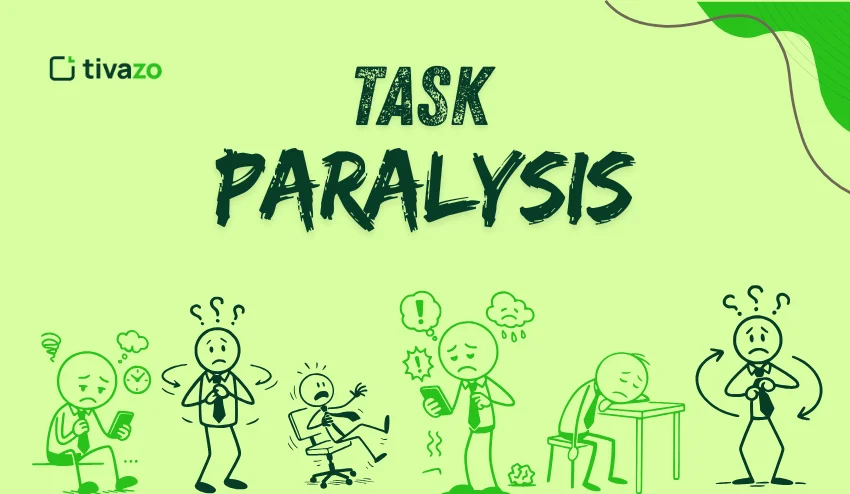The Planning Fallacy is a common psychological phenomenon in which people underestimate time, energy, and resources to achieve something, even when they have done so in the past. This is a cognitive bias identified by Daniel Kahneman and Amos Tversky in 1979. It affects people, teams, and businesses across industries.
The Planning Fallacy ranges from being late in projects or missing deadlines to looking unprofessional in business operations when they don’t appropriately account for the resources required. The Planning Fallacy can create stress, diminish productivity, and waste money and resources. Overconfidence in your accomplishments induces poor forecasting and unrealistic expectations that are not based on relevant data or experience, and can impact how long-term partnerships or clients see you as a serious and professional business partner.
Some academic researchers, personal goal setters, and team leaders initiate a project and overlook the planning fallacy. The Planning Fallacy is inevitable for many individuals, groups, and organizations when optimism surpasses common sense or pragmatism. The truth is, the Planning Fallacy is predictable and manageable if you know it exists. With careful consideration and proven frameworks, individuals can offset the bias bubble head and have better outcomes.
Key Highlights:
- What is the Planning Fallacy?
- Why does the Planning Fallacy Occur?
- What is a Good Example of a Planning Fallacy?
- Possible Positive Side Effects of the Planning Fallacy
- What is the Planning Fallacy in Business?
- Ways to Overcome the Planning Error
- How to Fix the Planning Fallacy in Teams
- Project management relates to the planning fallacy
What is the Planning Fallacy?
Planning Fallacy happens when people are too optimistic about going things. Rather than relying on a reasonable assessment or historical evidence, the person assumes “this time will be different.” This fallacy results in unrealistic expectations and people often underestimate important factors, such as:
- Time
- Costs
- Risks
- Required Resources
Key elements of Planning Fallacy
- Optimism Bias – The belief that things will be smoother than they are.
- Memory failures – failure to remember difficulties in the past.
- Focus on the best-case scenario – ignoring delays that may occur.
Planning Fallacy explains how people are repeatedly missing deadlines, or the reasons large-scale projects constantly exceed budget. People fall into and thinking that planning based on evidence, that is ideal rather than real, can create issues both in personal productivity and for businesses. Being aware of these patterns is the first step in developing more accurate and dependable plans.
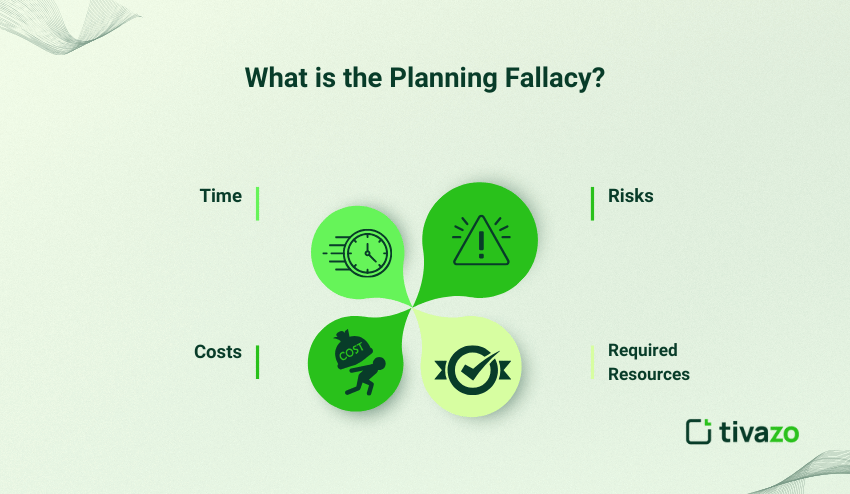
Examples of the Planning Fallacy in Different Situations
| Situation | Expectation | Reality | Implication |
| Personal Life | “I’m going to finish my essay in 2 hours.” | Essays take 6 – 8 hours | Stress, late submission. |
| Business | This product launch will be ready in 3 months | The project ends up taking 6 months, with additional costs | Missed deadlines, frustrated clients |
| Government | This highway will be completed in 2 years. | Construction ends up taking 5 + years and is over budget | Public dissatisfaction, wasted resources |
Why does the Planning Fallacy Occur?
Psychologists identify several reasons why the planning fallacy occurs:
- Cognitive Bias – People connect success to something that they will do; therefore, they focus on how they will complete the outcome and ignore the possible obstacles that will enter their way.
- Motivation – Leadership may deliberately under-plan to obtain stakeholders’ approval.
- Social Pressure – People on a team often do not want to come across as “slow”, “inefficient”, or “unproductive”.
- ADHD link – For people with ADHD, fallacy may create bigger issues when it also considers time blindness.
Also, the planning fallacy occurs when people rely too heavily on their internal assessments and not on any external evidence. Past failures and time estimates are treated as “exceptions, while future time outcomes must be seen as ‘easier or faster’ – which creates a cycle of continually recalculating poor outcomes on projects focused on goals and responsibilities.
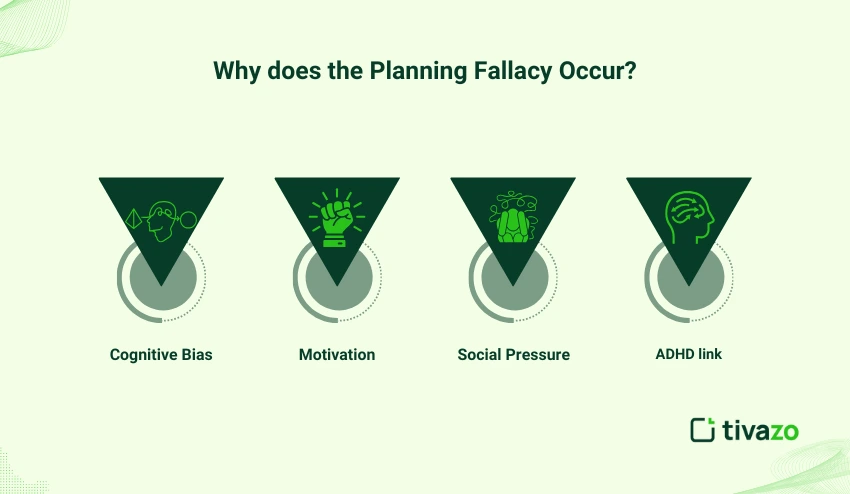
Example of the Planning Fallacy
| Situation | Expected time/cost upon completion | Actual time/cost upon completion |
| Student are writing their thesis | 2 months | 6 months |
| Implementing IT projects | $50.000 | $120.000 |
| Moving into a house | 3 days | 7 days |
| A government site for a new construction project | 2 years | 5+ years |
What is a Good Example of a Planning Fallacy?
An example of planning fallacy is students planning to finish an assignment in “just a few hours” only to take days due to both distractions and underestimating the time taken. This is one of the best examples of planning fallacy because students plan their estimated time based on the ideal case scenario – where they work diligently without breaks, learn everything immediately, and do not have interruptions. In practice, they spend more time doing research first, move to drafting an idea and their argument, figure to edit, and manage unexpected situations that take the time beyond their original judgment.
A planning fallacy is not limited to academia. For example, a team of software developers could believe they can complete a project in only three months, but end up needing six months when they consider planning, debugging, revisions, and coordination with others. In the same way, homeowners who believe that renovation work can be executed and completed in no time often find that the work cannot be completed in the planned timeline, while also incurring unexpected costs along the way due to delays from contractors or planning windows.
The examples used above show how planning fallacies permeate our daily lives, our businesses, and high-level projects, demonstrating that when you are optimistic for no reason, the opportunities for inaccurate investigations are considerable.
Possible Positive Side Effects of the Planning Fallacy
Believe it or not, the planning fallacy is not solely negative. There are some positives, including:
- Encouraging Ambition – People set difficult goals that stretch them and promote their personal or professional development.
- Encouraging Action – An optimistic projection reduces procrastination and creates urgency and confidence to begin immediately.
- Encouraging Risk-Taking – Teams take bold risks that they would not have attempted if they were fully aware of potential constraints. Thinking entrepreneurs will take calculated risks with possible breakthroughs or unique solutions.
In addition, the planning fallacy can create resilience. Where timelines extend or budgets expand, individuals and teams have taken in lessons from their mistakes and just gotten better at planning. It seems to create better collaboration as people reach out for help or resources, or alternative ways of achieving ambitious goals.
What is the Planning Fallacy in Business?
In a business context, the planning fallacy manifests in:
- Project Deadlines – Underestimating the time it takes to deliver.
- Budgeting – Not including unforeseen expenses.
- Product Launches – Thinking your product will be adopted by the market quickly.
- Hiring – Thinking you can fill the role quicker than you actually can.
Planning fallacy has many ramifications for business, like missed deadlines and budget blowouts, as well as frustrated clients. It also leads to allocating too many resources, employee burnout, and enough strain on stakeholders to damage relationships and reputation. If companies continually fall victim to the planning fallacy, then their reputation will take a hit, they may decrease profitability, and they’ll likely hinder their long-term strategic goals. Overcoming the planning fallacy provides the chance for organizations to grow at a sustainable rate and effectively manage projects.
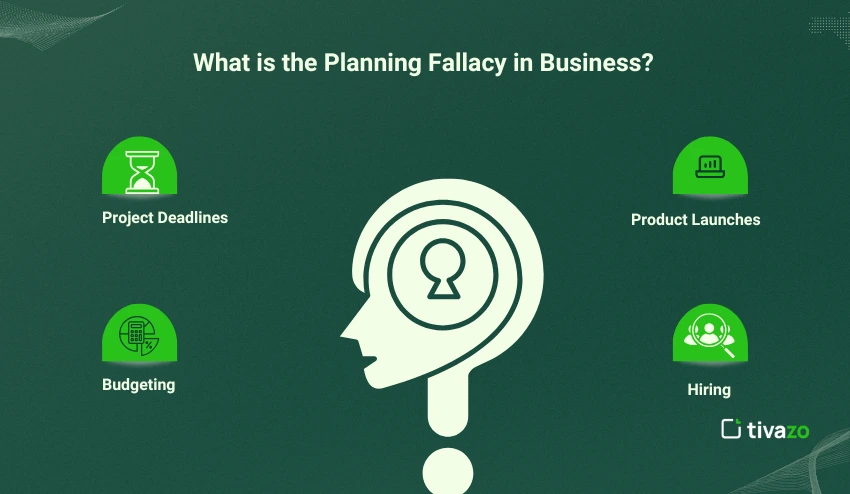
Planning ADHD
The planning fallacy can be even more challenging for those with ADHD because of time-blindness and executive function-related difficulties. Those with ADHD may always:
- Underestimate deadlines
- Overcommit activities into what appears to be a limited time frame
- Have a poor grasp of longer timelines in timeline projects
Importantly, these issues manifest into stress, missed deadlines, and feeling frustrated or overwhelmed. And traditional planning methods may be ineffective. Realistically structured tasks are imperative.
Solutions involve using reminders, external accountability, and realistic task splitting. Technology also aids in maintaining focus and tracking progress. Timers, calendars, and task management apps can all be useful tools for individuals with ADHD to combat time blindness and can greatly aid in their healthy management. Structured tasks as re-examination of whole tasks, can help those with ADHD plan more accurately and avoid the common parts of the planning fallacy.
Ways to Overcome the Planning Error
Below are seven strategies for overcoming the planning error:
1. Use Historical Data
Use historical data from the last projects to form realistic timescales and help you avoid repeating potentially avoidable mistakes.
2. Break Tasks at a Micro-Level
Take projects and turn them into smaller incremental tasks so that you can estimate the length and resource capacity with greater accuracy.
3. Include Buffer Time
Factor in 20-30% more time than you think you’ll need to accommodate for various types of delays or pressure as complication factors you didn’t expect.
4. Plan Scenarios
Plan best-case, worst-case, and likely-case scenarios to reduce optimism bias.
5. Accountability Checks
Have colleagues or function components check your timelines to reduce blind spots and build collaborative responsibility.
6. Use Project Management Tools
Connect to your team with project management tools like Trello, Asana, or Jira to track timelines, deadlines, and keep group members aware of progress.
7. Pre-mortem
Use everything you know and ask what could go wrong. This will help you identify potential problems before they become a reality.
How to Fix the Planning Fallacy in Teams
Encourage Transparency
Provide an environment for team members to express realistic concerns without being shamed. Having open discussions about possible roadblocks allows you to identify risks more quickly and to establish a more reliable timeline.
Track Progress
Continue examining your projects, referencing clear metrics, milestones, and timelines, and set regular check-ins. When you track a project, you can quickly adapt the original plan if/when a delay arises, and you will lessen the negative impact of the planning fallacy.
Avoid Overpromising
Avoid over-promising to your clients and stakeholders. When you set a realistic timeline and resource expectations with your clients and stakeholders, mental bandwidth is freed up to focus on the next project. Delivering projects late fosters disappointment.
Reward Accuracy
Praise and reward the team members who give realistic estimates and turn in a reasonable plan. When team members know there is potential praise or recognition, it encourages careful maxims of forecasting and encourages behavior as a culture of accountability.
Additionally, holding retrospective reviews after the completion of a project enables teams to evaluate other instances when they could have done better at planning. They can then explore any known characteristics that pollute predictions that can be employed in subsequent projects. While every project will face almost unknown circumstances, being able to accurately plan your next steps will lead to successful improvements in the level of planning and productivity, and positively diminish the equation we all face from this repetitive miscalculation.
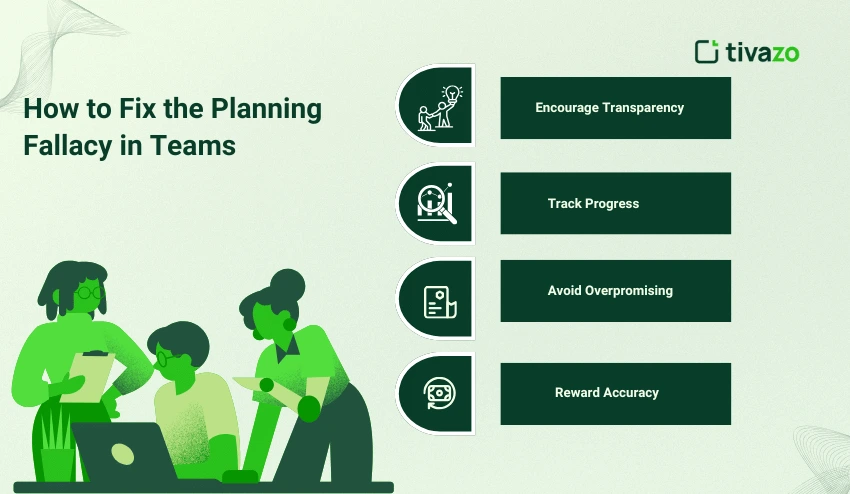
Project management relates to the planning fallacy
Project managers also tend to be at risk of the planning fallacy because they make estimates of timelines, resources, and budgets for technically complex and customized projects. There are many steps project managers can take to reduce the difficulty and risk of planning fallacy:
- Conduct regular reviews – Establish frequent intervals to keep everyone informed about progress towards completion, identify material bottlenecks to better track progress against project timelines in case re-scheduling may be warranted.
- Use techniques of evidence-based scheduling – Base estimates on evidence from historical data, the results of the activities completed in similar past projects, and your previous experience, even if optimistic. Check-in timelines with historical measures of success.
- Create budgets with contingency plans – Put aside sets of contingency funds. You might find yourself using these funds in response to unexpected costs or delays.
- Always track for scope creep – Keep track of any extra added articles or expectations, as a project could quickly get delayed.
Finally, project managers can encourage group/team input as estimates, while individual experiences are special to themselves, and sometimes there is collective experience that can create a more reasonable and accurate timeline and budget, and resource plan. Using project documentation journals, project scheduling software, and conducting postmortems of previous projects can also help to minimize the consequences of planning failure.
Conclusion
The planning fallacy is a common cognitive error that causes individuals, teams, and organizations to underestimate time, costs, and resources. Since students can underestimate assignments, and businesses can miscalculate project timelines, the planning fallacy has a significant and consistent impact that can be costly. Identifying the planning fallacy starts by understanding the salient features, namely, optimism bias, memory errors, and focusing on best-case scenarios. While there can be positive effects of the planning fallacy (e.g., optimism, ambition, innovation, motivation, etc.), the negative effects usually outweigh the potential benefits without identifying and addressing them.
There are many good strategies to consider to help mitigate the planning fallacy and get you to a better, more accurate place in your planning. Using prior historical performance data, breaking tasks down so it’s more manageable, factoring in additional time, risk scenario planning, accountability checks, project management tools, and pre-mortem analysis all lend themselves to a more accurate estimate. In addition, teams can consider creating an environment of transparency, accelerating accountability, minimizing over-promising, and rewarding staying on point with estimates. By identifying the planning fallacy and implementing some of these strategies, you and your organization will be able to plan better and more effectively, create reliable plans of action, and minimize stress from false planning.



